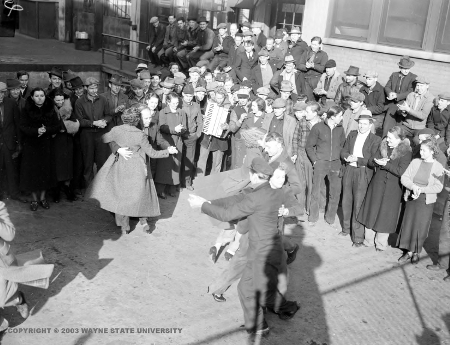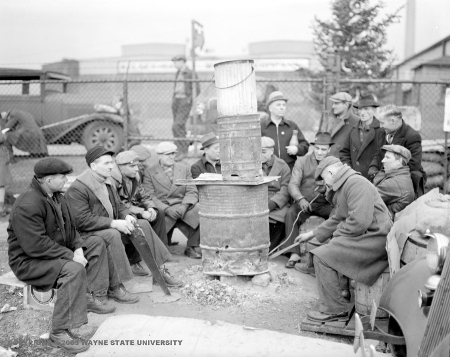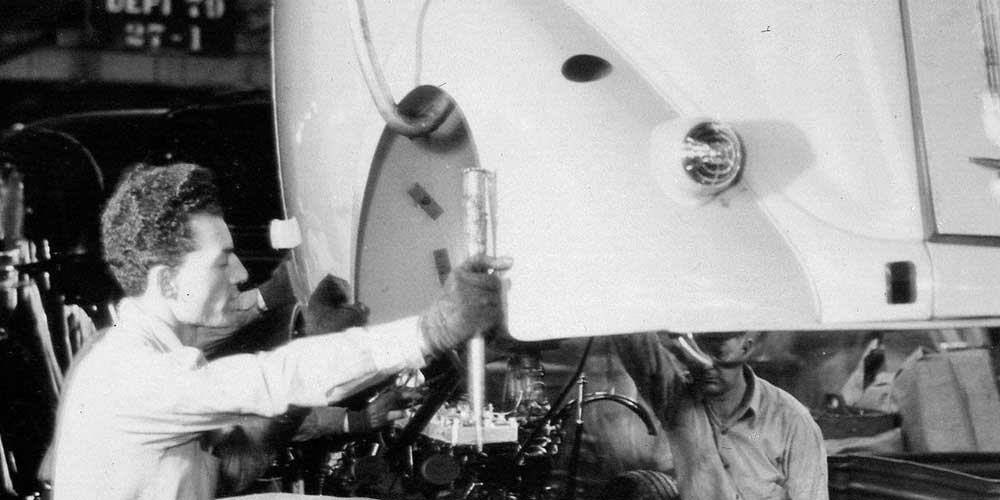Posted: 12.14.2016
As a special launch of the MotorCities Blog, we are honoring the first of several milestones in the evolution of of organized labor.
In December and into early 2017, the MotorCities National Heritage Area, working in conjunction with partners in southeast Michigan and beyond, will pay special tribute to our labor story which has touched nearly every aspect of the automotive and industrial heritage in the region.
This period marks a unique time with many labor anniversaries being recognized:
- 80th anniversary of the Kelsey-Hayes Sit-Down Strike
- 80th anniversary of the Flint Sit-Down Strike
- 85th anniversary of the Ford Hunger March
- 80th anniversary of the Battle of the Overpass
- 80th anniversary of the Lansing Labor Holiday
Our first article (and our first blog post) focuses on the the 80th anniversary of one of the first auto sit-down strikes in Michigan, held at the old Kelsey-Hayes Wheel Co. on Detroit’s west side. Men and women workers occupied the plant from Dec. 14, 1936, and the strike was finally settled on Christmas Eve, a few days before the most famous sit-down, at GM in Flint, began. (Courtesy of David Elsila)
Early Days of the Union: The Kelsey-Hayes Sit-Down Strike
By Jim Ward
(This article was originally published in the Summer, 2011 edition of the "Looking Back, Moving Forward" newsletter.)
 The year was 1935. On the streets of Detroit a bedraggled army of unemployed men and women marched from plant gate to plant gate in desperate search for work. In a scene that would be repeated a half century later, grown men were standing on street corners holding handmade signs begging for work. Those lucky enough to have jobs were forced to work under conditions designed to break their spirit. Wages were very low and constantly falling lower.
The year was 1935. On the streets of Detroit a bedraggled army of unemployed men and women marched from plant gate to plant gate in desperate search for work. In a scene that would be repeated a half century later, grown men were standing on street corners holding handmade signs begging for work. Those lucky enough to have jobs were forced to work under conditions designed to break their spirit. Wages were very low and constantly falling lower.
In the fall a toolmaker named Walter Reuther, who had been fired from Ford Motor Co. because management disliked his radical politics, returned to Detroit from a prolonged tour of Europe and Russia. Reuther and his younger brother Victor stepped into this labor tinderbox with the expressed purpose of turning the tiny United Auto Workers union into a force that could not be ignored by the auto industry titans.
LOCAL 174 VS. KELSEY-HAYES
Realizing that there was strength in numbers, the Reuther brothers and other organizers urged the individual weak unions on Detroit’s west side to pool their resources. In September 1936 their organizing effort led to the formation of UAW Local 174. Walter Reuther, then all of 29 years old, became their first president. The small local was comprised of only 78 members,
Their first target was Kelsey-Hayes Wheel which produced wheels and brake drums, mostly for Ford Motor Company. Kelsey was chosen for two reasons. It had a core of staunch union activists, and it had a relatively small work force—roughly 5,000 employees. The fledgling local stood a better chance of organizing Kelsey-Hayes than the massive Ford Rouge complex.
The organizers decided to concentrate on Department 49 at the McGraw Ave. plant. Department 49 had the highest number of signed up unionist. It also housed the hub and brake drum section, a cauldron of workers discontent. The foreman enjoyed riding roughshod over poorly paid workers who were hired in at only 37.5 cents an hour. Women were paid only 22.5 cents an hour for the same job. The site was ripe for organizing.
Victor Reuther, Merlin Bishop and George Edwards (who later became a federal judge) secured jobs in Department 49. With union organizers in place, all they needed was an incident to spark a strike. They found it when they learned that a young woman had fainted earlier in the year from demands of production line speed-up. As luck would have it, the woman was a union supporter and readily agreed to help.
 THE STRIKE… ’WE'VE HAD ENOUGH’
THE STRIKE… ’WE'VE HAD ENOUGH’
With details nailed down, the organizers set the strike for December 10, 1936. Since they planned a sit-in, they set up picket shifts and formed committee to feed the strikers and their families. Aware that company spies infiltrated most union gatherings, the organizers kept the date and time of the protest a closely guarded secret. At the agreed upon moment—twenty minutes before the end of the first shift—the young woman agreed to seem to faint again. But this time, when she fell to the floor she launched the beginning of the UAW as we know it.
In his book, The Brothers Reuther, Victor Reuther recalled what happened next. “I ran and pulled the main switch and shouted, ‘Strike. We’ve had enough of this speed-up.’ The call for strike action spread through our whole department and soon we had an enormous gathering around us.”
Upon seeing the determination of the workers, plant manager canceled the second shift and agreed to hold a formal negotiating session the next morning with union representatives from the plant on McGraw and another on Military. Jubilant over their success, the strikers went home to await new developments. That day alone Local 174 signed up hundreds of new members who were awed by the union’s ability to confront management.
In typical form, the Kelsey-Hayes management teambegan to stall. For days supervisors tried to cripple the organizing drive by bribing worker to support the company union, rather than Local 174.
SIT-DOWN STRIKE BEGINS
On Monday, December 14, 1936, the union called a general sit-down strike in both plants to protest Kelsey- Hayes’ refusal to bargain fairly. Some 500 men and women remained inside the plants while workers from all across Detroit rallied outside and blocked the entrances. The pickets and protesters thwarted Kelsey-Hayes’ attempt to move the equipment out of the plant, and more than 1,000 workers rushed to join the bold little Local. Whenever it was rumored that the company was readying an assault on the strikers, union brothers and sisters converged on the site to protect them.
Five days into the sit-down strike, Kelsey-Hayes slipped dozen of professional strikebreakers into the McGraw plant. Several thousand union members quickly surrounded the plant and began yelling “Throw the scabs out.” Shortly after the angry chants filled the air the scabs left the building.
The sit-down strikers also benefited from the refusal of local politicians and police agencies to evict them. Officials took the position that the protesters had entered the building legally as employees and had the right to remain there. As the days wore on, Kelsey-Hayes came under increasing pressure from its major customer, the Ford Motor Co. Ford was running low on parts.
Executives from both companies held an emergency meeting in Ford headquarters. Harry Bennett, the notorious hatchet man for Henry Ford, warned that if the strike was not settled, Ford would go elsewhere for supplies. That ultimatum forced Kelsey-Hayes to enter serious bargaining with Local 174.
VICTORY
On Christmas Eve, Local 174 reached a settlement. It called for a wage of 75 cents an hour, a shop steward system, a shop committee elected by UAW members, and a seniority system that governed the order of future layoffs and recall. The union negotiators secured a 20-percent reduction in the speed of the production line.
The sit-down strikers marched to the cheers of thousands who gathered to congratulate them on their victory. Victor Reuther wrote, “Everyone sensed that a new era had begun for auto workers.”
Within 10 short days Local 174 increased its members from 78 to 3,000. After the Kelsey-Hayes Wheel triumph, the phone at the west side Local was ringing every hour of the day and night: “Send us some soup and sandwiches; we’re sitting down on strike.”
Hours after the settlement, Victor Reuther and Merlin Bishop left for Flint where they played key roles in the GM sit-down strike. The 44-day protest which lasted from December 30, 1936 to February 11, 1937 thrust the UAW into the national spotlight. But it was the successful 10-day Kelsey-Hayes sit-down that paved the way for success in Flint.
Local 174 grew at a rapid pace. Sitdown fever spread through dozen of small plants and several large ones. By Christmas 1937, membership at the tiny Local that dared to take on giants of industry stood at 35,000. The Kelsey-Hayes Wheel Company had become the place where workers ushered in the birth of the UAW.
I have been trying for a couple years to get a Historical Marker on the site of the old Kelsey-Hayes Plant at McGraw and Livernois In honor of the early sitdown strikers, I didn’t know how difficult it would be. I have contacted the President of the Detroit City Council, the Detroit Historical Society, a labor historian in Virginia and the list goes on. I will continue my efforts so that what those men did in 1936 is not buried in the rubble of Kelsey-Hayes as they tear it down.
Jim Ward is a retired member of UAW Local 78. He has been involved in the campaign to place a Historical Marker at the site of the Kelsey-Hayes plant on the west side of Detroit.



